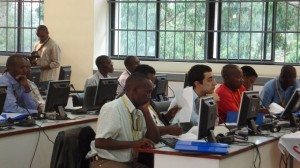The MVP introduces enhanced mobile technology to reduce child and maternal mortality

Children and mothers across the Millennium Villages (MV) will benefit from a new health application based on mobile phone technology that will be used at the household level in all sites.
The technology was presented to community health teams at a continent-wide workshop held in Nairobi in February 2010. The ChildCount+ application utilizes mobile phone technology to enhance maternal care and care for children under 5 at the household level. The new system is aimed at complementing the paper based system, ensuring real time data collection and eventually facilitating reductions in child and maternal deaths. The workshop brought together more than 40 Community Health Worker (CHWs) managers, data clerks and e-health specialists from across the 14 MV sites whose task it will be to implement the new ChildCount+ program.
The workshop had two main objectives: to develop and implement a community health events reporting and verbal autopsy system for CHWs; and to develop and implement a two-way mobile phone-based feedback and illness alert system for monitoring and managing follow-up for births and deaths of pregnant women and children under 5 years. The workshop also focused on training the new CHW managers, who have recently joined the project in all East and West Africa sites, with the goal to strengthen management and supervision of all 800 CHWs working in the villages. They also gained skills in specific management issues such as work scheduling, information flow management, supply chain management and clinical algorithms.
Under this new system, all CHWs will eventually have access to a mobile-phone based communication system for the reporting of community health events, a first of its kind in sub-Saharan Africa. The workshop participants learned how to use the system including which codes to enter in their mobiles to represent data on malaria, diarrhea, immunization, and other health interventions. These codes are then sent to a server operated by a database manager who will gather the information and share it with the CHW managers for feedback. The CHWs then get a message on their mobile phone directing them on the course of treatment of a child sick with malaria or suffering from acute malnutrition, for example.
On the last day, participants wrote down a 100 day plan of action to implement the ChildCount+ program and new management modules.
“The workshop was great, we learnt different methods of managing our CHWs, as well as the new rapid SMS techniques that will assist with making our work easier with the CHWs at the household level,” said Alex Kakama, a CHW manager from the Ruhiira Millennium Village, Uganda.
For Mahamane M’barakou from Mali, “The workshop gave us an opportunity to learn from our colleagues from the other sites. In case we have challenges, we can now communicate with our colleagues and get assistance for running this ChildCount+ program.”
The workshop provided much needed cross-site learning interaction and a forum for joint implementation of ChildCount+ and other management techniques that will eventually lead to the reduction of child and maternal mortality at the MVP.
ChildCount+ Goals Register every child – Create a “living” registry of all children under five in a community. This list provides the basis for CHWs to monitor the health status of their children.
Screen for malnutrition every 90 days for children from 6 months to 5 years. When a child with acute malnutrition is detected, the program provides support for Plumpy’nut based malnutrition treatment.
Monitor for malaria and diarrhea – track and treat the two major preventable causes of death in children under five. ChildCount+ provides support for home based malaria RDT testing and ACT dosing, and oral rehydration salt (ORS) usage.
Full child immunization support – Group all children in monthly age groups to know when a particular immunization is due. Record all immunizations and follow up with all children who are behind with their immunization schedule. Help manage vaccination campaigns.
Register all newborns and record when child deaths occur to enable local CHWs and communities to understand why.
This was originally posted on the Millennium Villages website on March 3, 2012.

Comments are closed